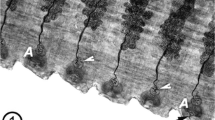Abstract
The copulatory organ in adult specimens of Archilopsis unipunctata has been studied by transmission electron microscopy.
This copulatory organ is of the conjuncta-duplex type with eversible cirrus. The seminal vesicle, lined with a nucleate epithelium, is surrounded by spirally arranged muscles. The fibres are enclosed in a sheath that is continuous with the septum of the bulbus and the basement lamina of the male canal epithelium. Distally to the seminal vesicle the bulbus is filled with the secretory cell-necks of the prostate glands. The male canal shows three different parts: seminal duct, ejaculatory duct and eversible cirrus. At the transition of seminal duct and ejaculatory duct two prostate ducts open into the lumen. The structure of the epithelium lining the different parts of the canal is described. The transition into the cirrus may be recognized by an abrupt change in the thickness, the electron density and the stratification in the basement lamina and by the disappearance of the epithelium absent indeed in the cirrus. The material found inside the cirrus-lumen is different according to the zone considered. The origin of this material and of the cirrus teeth is discussed.
Similar content being viewed by others
Abbreviations
- ab-:
-
apoptotic body
- ba-:
-
bacteria
- bb-:
-
basal bodies of cilia
- bl-:
-
basement lamina
- bw-:
-
body wall
- c-:
-
cilia
- cb-:
-
cell body
- cgp-:
-
common genital porus
- ci-:
-
cirrus
- cip-:
-
cirrus plug
- cl-:
-
lumen of cirrus
- cm-:
-
circular muscles
- cr-:
-
cytoplasmatic remnants
- cs-:
-
cytoplasmatic sheets
- ejd-:
-
ejaculatory duct
- epej-:
-
epithelium of ejaculatory duct
- d-:
-
desmosomes
- f-:
-
flagella of spermatozoa
- fd-:
-
female duct
- fp-:
-
female porus
- gc-:
-
golgi complex
- gl-:
-
glycogen particles
- hd-:
-
hemidesmosomes
- lm-:
-
longitudinal muscles
- ly-:
-
lysosome-like body
- m-:
-
muscles
- mb-:
-
muscles of the bulbus
- mc-:
-
muscles of the cirrus
- mc-:
-
muscles of the seminal vesicle
- mi-:
-
mitochondria
- ml-:
-
microvilli
- ms-:
-
mesenchyme
- nsd-:
-
nuclei of the seminal duct
- pd-:
-
prostate duct
- pg-:
-
prostate glands
- ri-:
-
ribosomes
- s-:
-
septum
- sb-:
-
secretory vesicle
- sd-:
-
seminal duct
- sp-:
-
spines
- sv-:
-
seminal vesicle
- v-:
-
vagina
- vd-:
-
vas deferens
References
Boaden, P. J. S., 1963. The interstitial fauna of some N. Wales beaches. J. Mar. Biol. Asssoc. U.K. 43: 79–96.
Dadoune, J. P., Terquem, A. & Alfonsi, M. F., 1978. High resolution radioautographic study of newly formed protein in striated muscle with emphasis on red and white fibres. Cell tissue Res. 193: 269–282.
Doe, D. A., 1976. The proboscis hooks in Karkinorhynchidae and Gnathorhinchidae (Turbellaria, Kalyptorhynchia) as basement membrane or intracellular specializations. Zool. Scripta 5: 105–115.
Dorset, D. A. & Roberts, J. B., 1980. A transverse tubular system and neuromuscular junctions in a molluscan unstriated muscle. Cell Tiss. Res. 206: 251–260.
Ehlers, U. & Ehlers, U., 1980. Structur and Differenzierung penialer Hartgebilde von Carenscoilia bidentata Soppott (Turbellaria, Proseriata). Zoomorphologie 95: 159–168.
Hendelberg, J., 1969. On the development of different types of spermatozoa from spermatids with two flagella in the Turbellaria, with remarks on the ultrastructure of the flagella. Zool. Bidr. Uppsala 38: 1–50.
Hendelberg, J., 1974. Spermiogenesis, sperm morphology and biology of fertilization in the Turbellaria. In: Eds. Riser, N. W. & Morse, M. P., Biology of the Turbellaria. New York: McGraw-Hill, 148–169.
Hendelberg, J., 1977. Comparative morphology of turbellarian spermatozoa studied by electron microscopy. Acta Zool. fenn. 154: 149–162.
Karling, T. G., 1956. Morphologisch-histologische Untersuchungen an den männlichen Atrialorganen der kalyptorhynchia (Turbellaria). Ark. Zool. Ser. 2, 7: 187–279.
Kerr, J. F. R., Wyllie A. H. & Currie, A. R., 1972. Apoptosis: a basic biological phenomenon with wideranging implications in tissue kinetics. Br. J. Cancer 26: 239–256.
Luther, A., 1960. Die Turbellarien Ostfennoskondiens I, Acoela, Catenulida, Macrostomida, Lecithoepitheliata, Prolecithophora und Proseriata. Fauna Fennica 7.
Mainitz, M., 1977. The fine structure of the stylet apparatus in Gnathostomulida Scleroperalia and its relationship to turbellarian In: Eds. Karling, T. G. & Meinander, M., The A. Luther Symposium on Turbellaria, Acta Zool. fenn. 154: 163–174.
Mainitz, M., 1979. The fine structure of Gnathostomulid reproductive organs. Zoomorphologie 92: 241–272.
Mattisson, A., Nilsson, S. & Fange, R., 1974. Light microscopical and ultrastructural organisation of muscles of Priapulus caudatus (Priapulida) and their responses to drugs, with phylogenetic remarks. Zool. Scripte 3: 209–218.
Økland, S., 1980. The heart ultrastructure of Lepidopleuris asellus (Spengler) and Tonicella mormorca (Fabricius) (Mollusca: Polyplacophora). Zoomorphologie 96: 1–19.
Reuter, M., 1977. Ultrastructure of the stylet protractor muscle in Gyratrix hemafroditus (Turbellaria, Rhabdocoela). Acta Zool. fenn. 58: 179–184.
Rieger, R. M. & Doe, D. A., 1975. The proboxis armature of Turbellaria — Kalyptorhynchia, a derivative of the basement lamina? Zool. Scripta 4: 25–32.
Rieger, R. M. & Mainitz, M., 1977. Comparative fine structure of the body wall in Gnathostomulida and their phylogenetic position between Platyhelminthes and Aschelminthes. Zeitschr. Zool. Syst. Evol.-forsch. 15: 9–35.
Rieger, R. M. & Ott, J., 1971. Gezeitenbedingte Wanderungen von Turbellarien und Nematoden eines nordadriatische Sandstrangens. Vie Milieu Suppl. 22: 425–447.
Soppott, B., 1972. Systematik und Ökologie von Proseriaten der deutschen Nordseeküste. Mirkofauna Meeresboden 13: 1–72.
Sterrer, W., 1968. Beiträge zur Kenntnis der Gnathostomulida. I. Anatomie und Morphologie des Genus Pterognathia Sterrer Ark. Zool. 22: 1–125.
Yunge, L., Benchimol, S. & Contin, M., 1980. Ultrastructural cytochemistry of atrial muscle cells (VIII). Cell Tiss. Res. 207: 1–11.
Author information
Authors and Affiliations
Rights and permissions
About this article
Cite this article
Martens, E.E., Schockaert, E.R. Observations on the ultrastructure of the copulatory organ of Archilopsis unipunctata (Fabricius, 1826) (Proseriata, Monocelididae). Hydrobiologia 84, 277–285 (1981). https://doi.org/10.1007/BF00026191
Issue Date:
DOI: https://doi.org/10.1007/BF00026191




